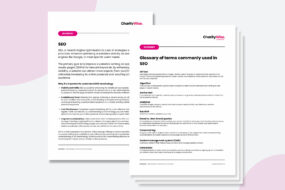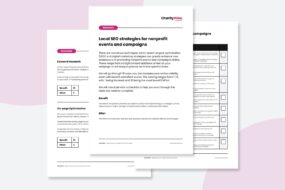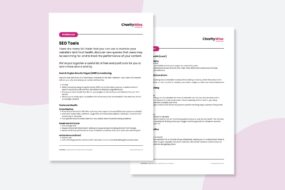

For independent local charities, setting aside budget for specialists in every digital discipline is often just not possible. SEO is a complex discipline that takes time to implement and longer to generate results. Because of this, it might not be that high on the marketing priority list – but it might also be the biggest source of traffic.
With this in mind, one thing that charities should do is focus their attention on specific elements of SEO, rather than try to tackle everything. Local SEO is one such element that may be worth your while. This guide provides an introduction to what it is, when and why it might be relevant to your organisation and outlines some basic things you can put into action straight away.
What is local SEO?
Simply, it’s the process of creating optimising digital assets, either on your own website or elsewhere, in ways that encourage more prominence for your organisation in search engines’ local results. This is specific to organic search results, not those that result from paid listings. The primary goal is, in most cases, to help people navigate to those locations or to get in touch (for example, by seeking out a local phone number).
People access these results in three primary ways:
- Mobile apps – Google or Apple Maps are often the default way for people to search for local organisations or locations. Creating and curating listings in these apps can help people discover your organisation, both in the conceptual and physical sense!
- Google & Bing Maps (browser) – Google provides easy access to its mapping through the browser, by including this as a tab on its regular web search results, or through what it calls a “map pack” that is inserted into the results themselves
- Local pages within web search results – organisations with multiple physical locations often have individual pages for each one. For example, Oxfam does this with its shops. These pages can then be served by search engines in normal web search results
When is local SEO relevant and how can it help?
The obvious answer is that it’s relevant if your organisation has a physical location that people can visit. It can also be useful to provide people with a clear idea of where you are based and any relevant catchment areas you have and ensure it’s easy for them to find out how to engage with you.
Consider from the perspective of your target audiences, whether service users, potential supporters or others, what type of information they might want about your organisation and its work. This might include:
- Locations – whether you have a charity shop on the high street, a facility where services are provided, an office address for correspondence…even unmanned drop-off points (see again Oxfam, who list clothing banks on their site)
- Service areas – mapping services allow listings to specify a service area where relevant, rather than a specific location. For example, a care service that provides home visits within a county or district
- Contact information – make it easy for people to find out how to get in touch with you, whether by phone, email or post. Again, provide clarity on when they can do this, what level of response they can expect and so on
- Reviews – a source of independent feedback on your organisation and the services it provides. These can be accessed directly from map listings and local search results, and are an important way for users of those tools to assess quality or service, for example
There are additional features with some of these tools that you could make use of – we’ll mention some of these below.
Ultimately, there’s no easy way to tell you through this blog post how relevant local SEO is to your organisation. Understanding this will guide how much effort to expend on it. This might necessitate testing the waters in a smaller way to judge the potential.
Things you can do to get started
Create profiles for Google, Apple and Bing’s mapping services.
This should ensure your business appears on their maps for relevant searches and in the correct location. You may need to verify ownership – for example, Google mails a one-time code to the address itself.
Ensure you populate each listing with accurate information and take care to ensure that addresses (and resultant map markers) are correct. Include a good quality photo of the location – not including one could result in a random image being used in some places.
Ensure your website is accurate and up to date
This might sound obvious, but it’s easy to overlook important details. Marketers can tend to focus on the outcomes they want (donations, newsletter signups or social engagement) at the expense of things that are important to web users.
Assuming you’ve covered the basic requirements set out by the Charity Commission, consider how you can go further and make it easy for people to find what they need quickly. The old UX soundbite “don’t make me think” is always useful to keep in mind.
Create listings on reputable directories
Sites like Yell.com and Thomson Local still have value and are worth creating listings on within the relevant categories. There are also charity-specific sites like Charitychoice.co.uk and Workforgood.co.uk. Think about which sites are relevant to your organisation and, again, populate with relevant facts and business information.
However, don’t target any old directory, as many have been devalued by search engines. For example, some will distribute one listing across dozens of low-quality sites. In general, stick with reputable business directories that you or your target audience are likely to know of.
Encourage people to leave reviews on your listings
For each listing you have on Google, Bing and Apple maps, reviews provide impartial social proof for people researching your organisation. They might do this before deciding to commit their support, so it’s important they get an accurate impression. For example, you might discreetly ask existing supporters or service users to leave a review if it’s appropriate.
It’s important to allow an accurate picture to develop here – people will quickly see through attempts to massage your reputation (for example, by deleting negative reviews). They are more likely to appreciate proactive responses to negative reviews, so try to engage with these constructively and, it hopefully goes without saying, respectfully.
Build local connections and reputation
Local SEO can be seen as an extension of your efforts to build reputation and promote your charity in your area. People who see your site listed in local results will be influenced in their choice to click (or not) in part by what they already know about your organisation. Positive coverage in local press, or partnerships with other local organisations will all help indirectly in the long-run.
Google’s search algorithms are known to include data showing how users behave on its search results as a factor in how sites rank. A lack of audience awareness, or negative reputational factors, could prove harmful. In other words, if your site ranks well but is never clicked on, its rankings might suffer imperceptibly over time in favour of a comparable, but more popular, site. These are things that we cannot quantify (because Google does not release that data) but we can influence.
Measure and keep learning
Use the data provided by the platform providers to understand how your site and listings perform. For example, Google Search Console and Google Business Profile give you data on your organic performance that will keep you informed of trends and provide insights you can use to improve.
To do this, try to keep growing your knowledge so that you can start to make use of additional features such as Q&A and Posts. The resources and events here at Charity Wise will help you – or consider booking time with one of our specialists who can answer your questions.




